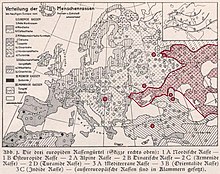| Revision as of 18:01, 20 August 2024 editBD2412 (talk | contribs)Autopatrolled, IP block exemptions, Administrators2,454,665 editsm →History: clean up Washington, D.C. punctuation issues, replaced: Washington, D.C | → Washington, D.C. |Tag: AWB← Previous edit | Latest revision as of 23:13, 11 October 2024 edit undo77.47.38.183 (talk) →History: The turanid race, as suggested in historical anthropological research, was recognised to have varying amounts of “mongoloid admixture”, often timed quite substantial depending on the branch of turanidTags: Mobile edit Mobile web edit | ||
| (3 intermediate revisions by 2 users not shown) | |||
| Line 4: | Line 4: | ||
| == History == | == History == | ||
| ] of the 19th and early 20th century posited the existence of a Turanid ] or "minor race" as a subtype of the Caucasoid race with |
] of the 19th and early 20th century posited the existence of a Turanid ] or "minor race" as a subtype of the Caucasoid race with ] admixture, situated at the boundary of the distribution of the Mongoloid and Caucasoid races.<ref>{{cite book|url=https://books.google.com/books?id=01LfoBC6jZkC&dq=turanid+race&pg=PA32 |title=Racial and cultural minorities: an analysis of prejudice and discrimination, Environment, development, and public policy |author-first1=George Eaton |author-last1=Simpson |author-first2=John Milton |author-last2=Yinger |publisher=Springer |date=1985 |isbn=0-306-41777-4 |pages=32}}</ref><ref>{{cite journal|author-first=Gloria |author-last=Y'Edynak |title=Physical: Avars and Ancient Hungarians. Pal Liptak |journal=] |publisher=American Anthropological Association, Anthropological Society of Washington |location=Washington, D.C. |date=1984 |volume=86 |number=3 |page=741 |doi=10.1525/aa.1984.86.3.02a00530}}</ref> | ||
| The idea of a Turanid race came to play a role of some significance in ] or ] in the late 19th to 20th century. A "Turkish race" was proposed as a Caucasoid subtype in European literature of the period. | The idea of a Turanid race came to play a role of some significance in ] or ] in the late 19th to 20th century. A "Turkish race" was proposed as a Caucasoid subtype in European literature of the period. | ||
| Line 16: | Line 16: | ||
| ==References== | ==References== | ||
| {{reflist}} | {{reflist}} | ||
| == Further reading == | |||
| * Leon Cahun ''L’histoire de l’Asie'' (1896). | |||
| * ], ''Turaniden-Studien'', Akademie der Wissenschaften und der Literatur, F. Steiner Verlag, Mainz, (1950). | |||
| {{Historical definitions of race}} | {{Historical definitions of race}} | ||
Latest revision as of 23:13, 11 October 2024
Outdated grouping of human beings
The Turanid race was a supposed sub-race of the Caucasian race in the context of a now-outdated model of dividing humanity into different races which was developed originally by Europeans in support of colonialism. The Turanid type was traditionally held to be most common among the populations native to Central Asia. The name is taken from the phylum of Turanian languages, which are the combination of the Uralic and Altaic families, hence also referred to as the term Ural–Altaic race.
History
Anthropologists of the 19th and early 20th century posited the existence of a Turanid racial type or "minor race" as a subtype of the Caucasoid race with Mongoloid admixture, situated at the boundary of the distribution of the Mongoloid and Caucasoid races.
The idea of a Turanid race came to play a role of some significance in Pan-Turkism or Turanism in the late 19th to 20th century. A "Turkish race" was proposed as a Caucasoid subtype in European literature of the period.
The most influential of these sources were Histoire Générale des Huns, des Turcs, des Mongols, et autres Tartares Occidentaux (1756–1758) by Joseph de Guignes (1721–1800), and Sketches of Central Asia (1867) by Ármin Vámbéry, which was on the common origins of Turkic groups as belonging to one race, but subdivided according to physical traits and customs, and L'histoire de l'Asie (1896) by Leon Cahun, which stressed the role of Turks in "carrying civilization to Europe", as a part of the greater "Turanid race" that included the Uralic and Altaic speaking peoples more generally. There was also an ideology of Hungarian Turanism most lively in the second half of the 19th century and in the first half of the 20th century.
See also
References
- For the model of dividing humanity into races, see American Association of Physical Anthropologists (27 March 2019). "AAPA Statement on Race and Racism". American Association of Physical Anthropologists. Retrieved 19 June 2020.
Instead, the Western concept of race must be understood as a classification system that emerged from, and in support of, European colonialism, oppression, and discrimination.
- Coon, Carleton S. "The Races of Europe".
- Simpson, George Eaton; Yinger, John Milton (1985). Racial and cultural minorities: an analysis of prejudice and discrimination, Environment, development, and public policy. Springer. p. 32. ISBN 0-306-41777-4.
- Y'Edynak, Gloria (1984). "Physical: Avars and Ancient Hungarians. Pal Liptak". American Anthropologist. 86 (3). Washington, D.C.: American Anthropological Association, Anthropological Society of Washington: 741. doi:10.1525/aa.1984.86.3.02a00530.
- z Kibris, Gülden (2005). Creating Turkishness: An Examination of Turkish Nationalism through Gök-Börü (PDF). Sabancı University. Archived from the original (PDF) on 19 January 2010. Retrieved 5 December 2007.